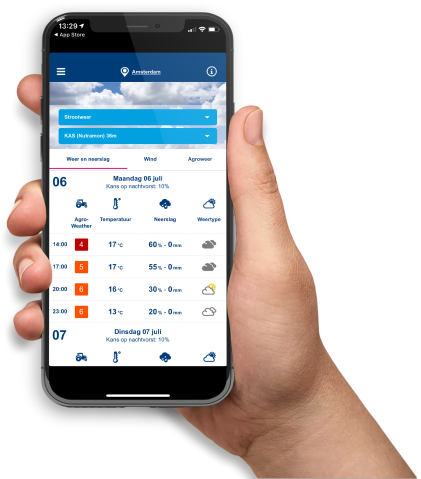Understanding spreading tables
Consult the setting chart
A correctly adjusted fertiliser spreader is important to achieve a good spreading pattern. To adjust the spreader correctly, consult the setting chart.
Spreading tables can be found on the websites of the spreader manufacturer. In addition, almost all spreader manufacturers have an application. This application can be consulted to quickly look up the spreading tables. The spreading tables supplied in booklets with the spreader are rarely up-to-date. This is because physical properties of fertilisers change over the years and the spreading tables are not updated accordingly.
Spreading table information
The setting chart provides information on the adjustment of the spreader needed to achieve a certain output at a certain driving speed. The desired output in kilograms per hectare must therefore be known before spreading. The desired working width and the fertiliser to be spread must also be known in advance. What further information is required when looking for the right spreading table depends on the brand of spreader.
A spreading table contains the following information that is important when adjusting the spreader:
- Spreader type;
- Dosing slide setting;
- Blade position;
- Angle of the spreader;
- Travel speed;
- PTO speed;
- Poison per hectare.
Using the setting chart
A spreading table can be completed in two ways. In the first way, the fertiliser to be spread (brand and type) is entered. In this way, the fertiliser’s properties are already known. This means that the spreader manufacturer has already carried out tests with this fertiliser and based the correct adjustment on it. This can then be found in the spreading table.
However, there may be discrepancies between the mineral fertilisers used to compile the setting chart and the fertiliser supplied. Therefore, when adjusting the spreader, not only the type but also the quality of the fertiliser is a concern. It is therefore important that you also look at the ratio of the granules and not just the name of the granules.
A second way to find the right spreading table is to use the physical properties of the fertiliser. The physical properties of fraction distribution, hardness and bulk weight are most important here. In this way, the right spreading table can be found for almost any fertiliser.
If no table can be found for large working widths after entering the physical properties, this is because the working size is too wide. Spreading the fertiliser at this width would result in large deviations in the spreading pattern, because the fertiliser does not have the desired properties for this purpose.
The fertiliser used may not yet have a spreading table available. This is because the fertiliser is new and no tests have yet been carried out with it. Therefore, the adjustment of the spreader can sometimes cause problems when using new fertilisers.
Common mistakes
When looking for the right spreading table and adjusting the spreader, one regularly encounters problems. Common mistakes made when adjusting a spreader are:
- Choosing the wrong spreading table;
- Spreader does not hang at the right height;
- Fertiliser spreader hangs too far forward or back;
- Wrong PTO speed during spreading.
Source:
Berg, 2013.
Roelofs, 2010.
Schriek R. v., 2012.
Smits, Strooien over het gewas vergt precisie, 2008.


